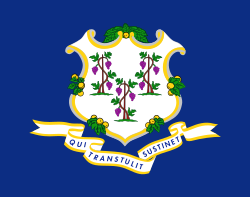- The naval Red Ensign of the former Kingdom of England, from which the flags of New England are derived. [15]
- The First Flag (and Ensign) of New England used by merchant ships sailing out of New England ports.
- After the union of England and Scotland, some New England ensigns used the British Union Flag rather than St. George's Cross. [16]
- The Flag of New England with St George's Cross removed. [17]
- The Flag flown during the Dominion of New England, using the personal standard of Edmund Andros
 | |
| Use | Civil and state flag |
|---|---|
| Proportion | 3:4 |
| Adopted | September 9, 1897 |
| Design | A white shield with three grapevines on a field of royal/azure blue. |
 Azure blue variant | |
The flag of the U.S. state of Connecticut is a white baroque shield with three grapevines, each bearing three bunches of purple grapes on a field of royal blue. The banner below the shield reads "Qui Transtulit Sustinet," Latin for "He who transplanted sustains," Connecticut's state motto. The flag dimensions are 5.5 feet (1.7 m) in length and 4.33 feet (1.32 m) in width. [1]









